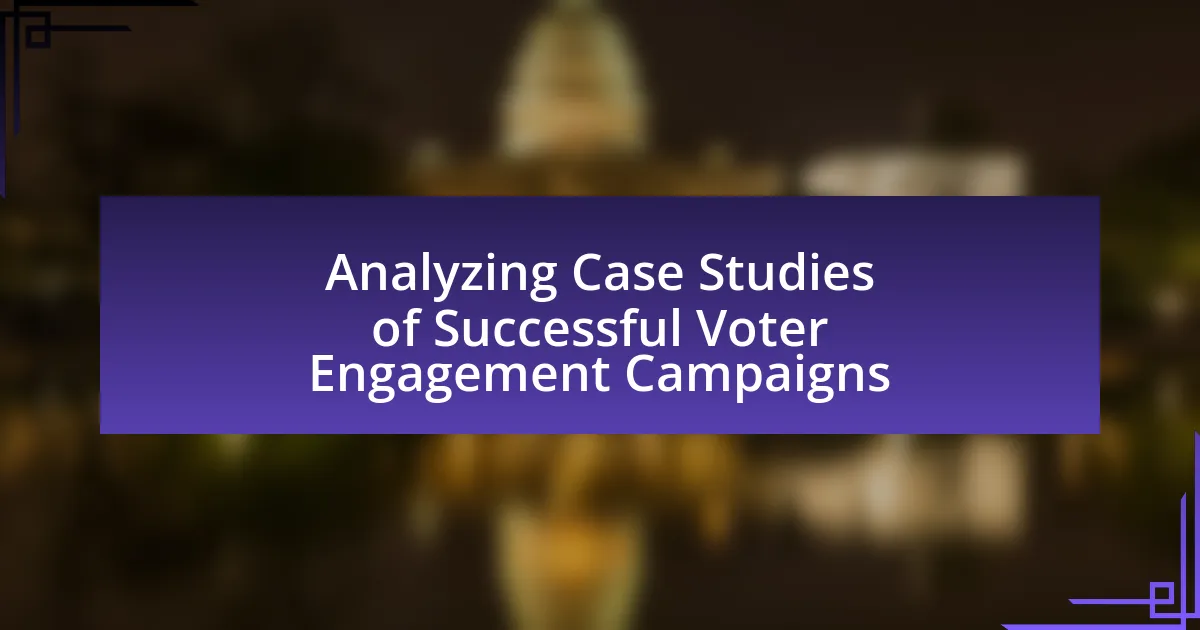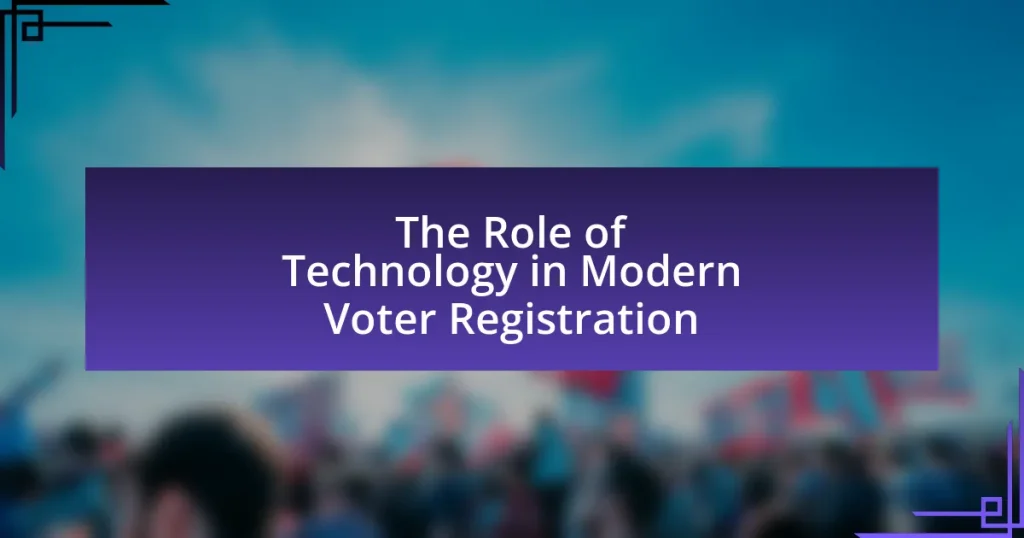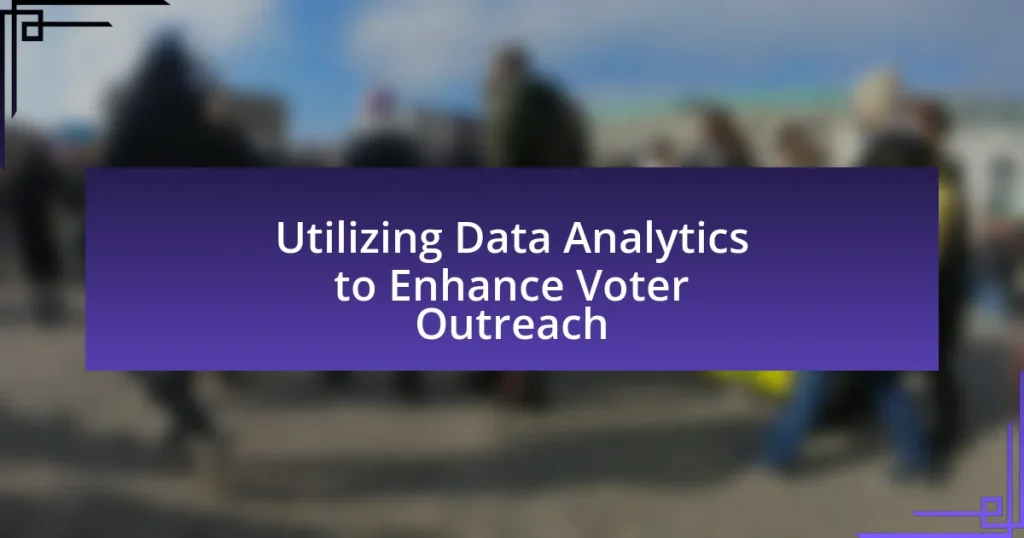The article focuses on analyzing case studies of successful voter engagement campaigns, highlighting the strategies and metrics that contribute to increased voter participation. It defines successful campaigns as those that utilize targeted outreach, community involvement, and data-driven strategies to mobilize specific demographics. Key metrics for measuring success include voter turnout rates, social media engagement, and outreach effectiveness. The article also discusses the importance of understanding different demographics, combating misinformation, and fostering collaboration among organizations to enhance voter engagement and strengthen democracy.
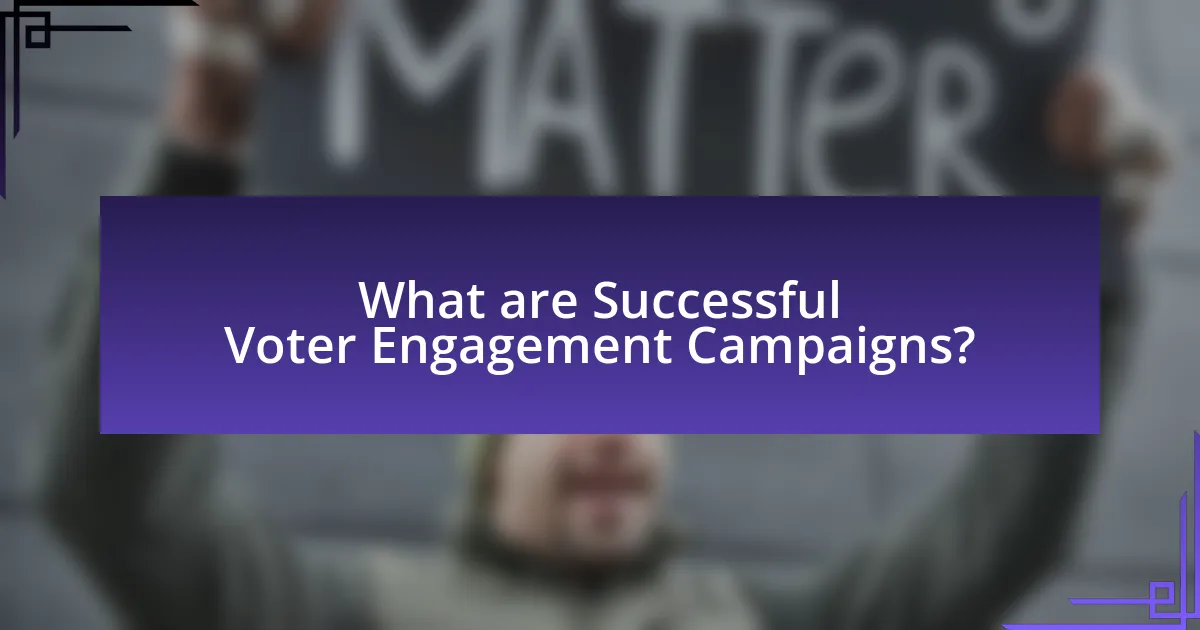
What are Successful Voter Engagement Campaigns?
Successful voter engagement campaigns are strategic initiatives designed to increase voter participation and awareness in elections. These campaigns often utilize targeted outreach methods, such as door-to-door canvassing, social media engagement, and community events, to connect with potential voters. For example, the 2008 Obama campaign effectively used data analytics to identify and mobilize key demographics, resulting in a significant increase in voter turnout, particularly among young and minority voters. This approach demonstrates that successful voter engagement campaigns rely on understanding the audience and employing tailored strategies to motivate participation.
How do we define success in voter engagement campaigns?
Success in voter engagement campaigns is defined by measurable increases in voter turnout and participation rates among targeted demographics. For instance, the 2020 U.S. presidential election saw a record turnout of approximately 66.8% of the eligible voting population, attributed in part to effective voter engagement strategies that mobilized underrepresented groups. Additionally, success can be evaluated through metrics such as the number of registered voters, the effectiveness of outreach efforts, and the level of community involvement in the electoral process. These indicators provide concrete evidence of the campaign’s impact on enhancing civic participation.
What metrics are used to measure the success of these campaigns?
The metrics used to measure the success of voter engagement campaigns include voter turnout rates, engagement levels on social media, and the number of individuals reached through outreach efforts. Voter turnout rates provide a direct indication of the campaign’s effectiveness in mobilizing voters, with studies showing that targeted campaigns can increase turnout by as much as 5-10%. Engagement levels on social media, such as likes, shares, and comments, reflect the campaign’s ability to resonate with the audience, while outreach metrics, including door-to-door interactions and event attendance, quantify the campaign’s reach and influence. These metrics collectively offer a comprehensive view of a campaign’s impact on voter participation.
How do different demographics influence the definition of success?
Different demographics significantly influence the definition of success by shaping individual and collective values, priorities, and experiences. For instance, younger demographics may define success in terms of social impact and personal fulfillment, while older generations might prioritize financial stability and career achievements. Research from the Pew Research Center indicates that cultural background, education level, and socioeconomic status all contribute to varying perceptions of success, with diverse groups emphasizing different metrics such as community involvement, professional advancement, or personal happiness. This variation highlights how demographic factors create distinct frameworks for evaluating success, ultimately affecting voter engagement strategies in campaigns.
Why are voter engagement campaigns important?
Voter engagement campaigns are important because they significantly increase voter turnout and participation in the democratic process. Research indicates that targeted voter engagement efforts can raise turnout rates by as much as 10% in specific demographics, as evidenced by the 2018 midterm elections where organizations like Rock the Vote mobilized young voters, resulting in a record turnout of 50% among eligible voters aged 18-29. These campaigns educate citizens about their voting rights, provide information on the electoral process, and foster a sense of civic responsibility, ultimately strengthening democracy and ensuring that diverse voices are heard in decision-making.
What impact do these campaigns have on voter turnout?
Voter engagement campaigns significantly increase voter turnout. Research indicates that targeted outreach efforts, such as door-to-door canvassing and personalized communication, can raise participation rates by as much as 10% to 20%. For instance, a study by the National Bureau of Economic Research found that door-to-door canvassing increased turnout by 7% in the 2006 midterm elections. Additionally, campaigns that utilize social media effectively can mobilize younger voters, who are typically less likely to participate, leading to higher overall turnout.
How do they contribute to the overall health of democracy?
Successful voter engagement campaigns contribute to the overall health of democracy by increasing voter participation and fostering informed citizenry. These campaigns mobilize underrepresented populations, ensuring diverse voices are heard in the electoral process, which enhances the legitimacy of democratic institutions. For instance, the 2020 U.S. elections saw a record turnout of 159 million voters, largely attributed to targeted outreach efforts by organizations like the NAACP and Vote.org, which focused on engaging young voters and communities of color. This increased engagement not only reflects a more representative electorate but also strengthens accountability among elected officials, as they are more likely to respond to the needs of an active and informed citizenry.
What strategies are commonly used in successful voter engagement campaigns?
Successful voter engagement campaigns commonly utilize strategies such as targeted outreach, grassroots mobilization, and digital engagement. Targeted outreach involves identifying specific demographics and tailoring messages to resonate with those groups, which has been shown to increase participation rates. Grassroots mobilization focuses on community organizing and building local networks to encourage voter turnout, exemplified by campaigns like the 2008 Obama campaign that effectively mobilized volunteers. Digital engagement leverages social media platforms to reach younger voters, as evidenced by the significant impact of online campaigns in the 2020 elections, where platforms like Instagram and TikTok were used to inform and motivate voters. These strategies collectively enhance voter participation and engagement.
How do grassroots efforts differ from digital campaigns?
Grassroots efforts differ from digital campaigns primarily in their approach to mobilizing support and engaging with the community. Grassroots efforts focus on face-to-face interactions, community organizing, and building relationships through local events, while digital campaigns leverage online platforms, social media, and digital advertising to reach a broader audience quickly. For instance, a grassroots campaign may involve door-to-door canvassing and town hall meetings, which fosters personal connections and local involvement, whereas a digital campaign might utilize targeted ads on social media to engage users based on their online behavior and demographics. This distinction highlights the varying methods of outreach and engagement, with grassroots efforts emphasizing personal touch and community ties, and digital campaigns prioritizing speed and scalability.
What role does messaging play in these campaigns?
Messaging serves as a critical component in voter engagement campaigns by shaping public perception and motivating action. Effective messaging communicates key issues, resonates with target audiences, and fosters emotional connections, which are essential for mobilizing voters. For instance, campaigns that utilize clear, relatable messaging have been shown to increase voter turnout; a study by the Pew Research Center found that 60% of voters cited persuasive messaging as a significant factor in their decision to participate in elections. This demonstrates that well-crafted messaging not only informs but also inspires individuals to engage in the electoral process.
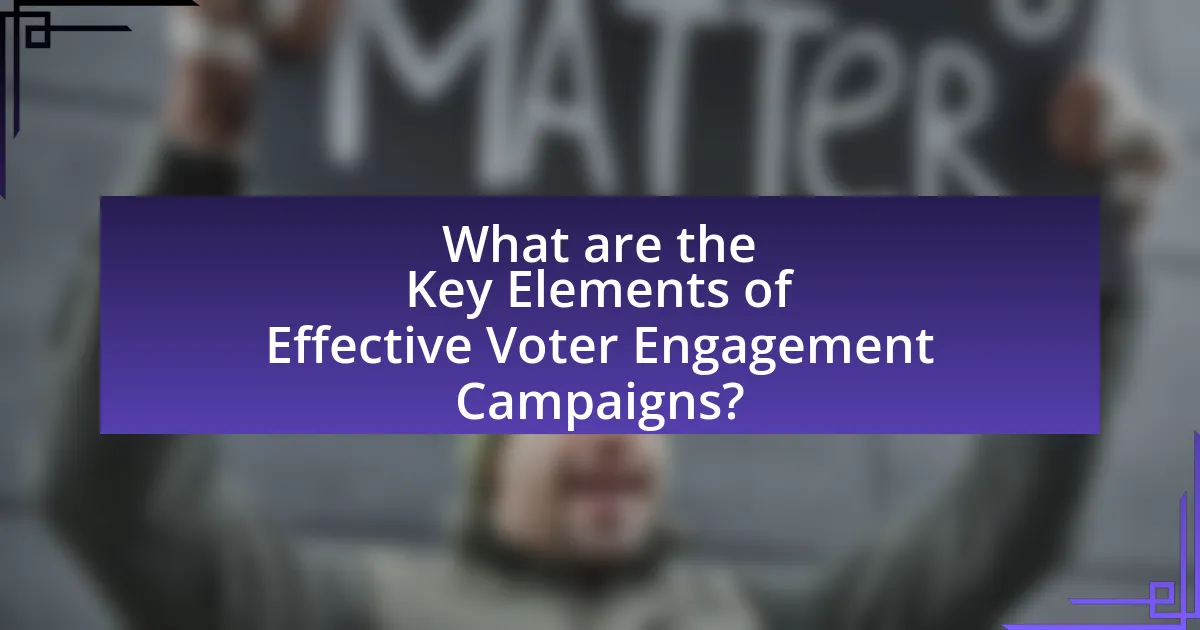
What are the Key Elements of Effective Voter Engagement Campaigns?
Key elements of effective voter engagement campaigns include targeted messaging, community involvement, and data-driven strategies. Targeted messaging ensures that communication resonates with specific demographics, increasing the likelihood of engagement; for instance, campaigns that tailor their messages to young voters often see higher turnout rates. Community involvement fosters trust and encourages participation, as evidenced by grassroots efforts that mobilize local leaders to advocate for voting. Data-driven strategies utilize analytics to identify potential voters and optimize outreach efforts, leading to more efficient resource allocation and improved engagement outcomes. These elements collectively enhance the effectiveness of voter engagement campaigns, as demonstrated by successful initiatives in various electoral contexts.
How does audience targeting enhance campaign effectiveness?
Audience targeting enhances campaign effectiveness by ensuring that messages reach the most relevant individuals, thereby increasing engagement and conversion rates. When campaigns are tailored to specific demographics, interests, and behaviors, they resonate more deeply with the audience, leading to higher participation levels. For instance, a study by the Pew Research Center found that targeted political ads can increase voter turnout by up to 20% when they align closely with the interests and values of the audience. This precision in targeting not only maximizes resource allocation but also fosters a stronger connection between the campaign and its constituents, ultimately driving more successful outcomes.
What tools are used for audience segmentation?
Audience segmentation tools include customer relationship management (CRM) software, data analytics platforms, and social media analytics tools. CRM software like Salesforce allows organizations to categorize voters based on demographics and behavior, enabling targeted outreach. Data analytics platforms such as Google Analytics provide insights into user behavior and preferences, facilitating segmentation based on engagement metrics. Social media analytics tools, like Hootsuite Insights, help identify audience interests and trends, allowing for more effective targeting in voter engagement campaigns. These tools are essential for tailoring messages and strategies to specific voter groups, enhancing the effectiveness of engagement efforts.
How can understanding voter behavior improve targeting?
Understanding voter behavior can significantly improve targeting by enabling campaigns to tailor their messages and outreach strategies to specific demographics and preferences. By analyzing data on voter motivations, preferences, and past voting patterns, campaigns can identify key segments of the electorate that are more likely to respond positively to particular messages or initiatives. For instance, research from the Pew Research Center indicates that targeted messaging based on demographic factors such as age, education, and political affiliation can increase voter engagement and turnout by as much as 20%. This data-driven approach allows campaigns to allocate resources more effectively, ensuring that efforts are concentrated on the most receptive audiences, ultimately enhancing the likelihood of electoral success.
What role does collaboration play in successful campaigns?
Collaboration is essential for successful campaigns as it enhances resource sharing, diverse perspectives, and unified messaging. In successful voter engagement campaigns, collaboration among various stakeholders—such as community organizations, political groups, and volunteers—leads to more effective outreach and mobilization strategies. For instance, the 2008 Obama campaign effectively utilized collaboration by integrating grassroots organizations, which resulted in a record voter turnout of 69.5%, the highest for a presidential election since 1900. This demonstrates that collaborative efforts can significantly amplify campaign impact and effectiveness.
How can partnerships with local organizations amplify efforts?
Partnerships with local organizations can amplify efforts by leveraging their established community trust and networks. These organizations often have deep-rooted connections and insights into the specific needs and concerns of the community, which can enhance outreach strategies. For instance, a study by the Pew Research Center found that community-based organizations significantly increase voter turnout by providing tailored information and mobilization efforts that resonate with local populations. By collaborating with these organizations, campaigns can access resources, volunteers, and local knowledge that improve engagement and effectiveness, ultimately leading to higher participation rates in elections.
What are the benefits of coalition-building in voter engagement?
Coalition-building in voter engagement enhances outreach, mobilization, and resource sharing among diverse groups. By uniting various organizations and communities, coalitions can leverage collective strengths to reach a broader audience, thereby increasing voter turnout. For instance, the 2018 midterm elections in the United States saw coalitions like the “Vote.org” initiative, which combined efforts from multiple organizations to facilitate voter registration and education, resulting in a record turnout of 50% of eligible voters, the highest for a midterm election in over a century. This demonstrates that coalition-building not only amplifies individual efforts but also creates a more inclusive and effective voter engagement strategy.
What are some common challenges faced in voter engagement campaigns?
Common challenges faced in voter engagement campaigns include reaching diverse populations, combating misinformation, and ensuring accessibility. Reaching diverse populations can be difficult due to language barriers and cultural differences, which may hinder effective communication. Combating misinformation is crucial, as false narratives can dissuade potential voters from participating; for instance, a 2020 study by the Pew Research Center found that 64% of Americans reported encountering false information about the election. Ensuring accessibility is also a significant challenge, as physical and technological barriers can prevent individuals with disabilities or those in remote areas from engaging in the voting process.
How can misinformation affect voter engagement efforts?
Misinformation can significantly undermine voter engagement efforts by creating confusion and distrust among potential voters. When false information circulates, it can lead to misperceptions about voting procedures, candidate positions, and election dates, ultimately discouraging individuals from participating in the electoral process. For instance, a study by the Pew Research Center found that 64% of Americans believe misinformation has a major impact on public confidence in elections, which directly correlates with lower voter turnout. This demonstrates that misinformation not only distorts the truth but also erodes the foundational trust necessary for a healthy democratic process.
What strategies can mitigate the impact of voter apathy?
Strategies to mitigate the impact of voter apathy include increasing voter education, enhancing accessibility to voting, and fostering community engagement. Voter education initiatives, such as workshops and informational campaigns, inform citizens about the voting process and the importance of their participation, which can lead to higher turnout rates. For instance, the National Voter Registration Act of 1993 aimed to simplify voter registration and has been linked to increased voter participation. Enhancing accessibility involves measures like extending voting hours, providing transportation to polling places, and ensuring that voting materials are available in multiple languages, which can significantly reduce barriers to participation. Community engagement strategies, such as grassroots organizing and partnerships with local organizations, create a sense of ownership and responsibility among citizens, motivating them to vote. Research by the Pew Research Center indicates that communities with strong social networks see higher voter turnout, demonstrating the effectiveness of these strategies.
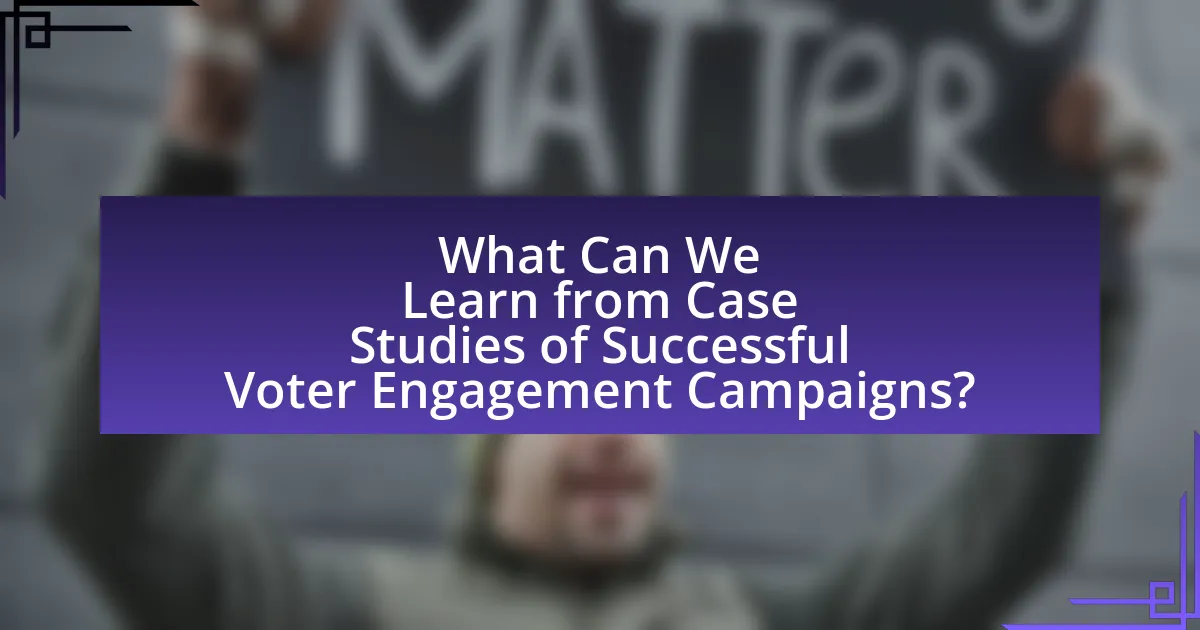
What Can We Learn from Case Studies of Successful Voter Engagement Campaigns?
Case studies of successful voter engagement campaigns reveal that targeted messaging, community involvement, and data-driven strategies significantly enhance voter turnout. For instance, the 2018 midterm elections in the United States saw organizations like Vote.org utilize tailored outreach efforts, resulting in a 50% increase in voter registration compared to previous years. Additionally, the use of social media platforms to engage younger voters proved effective, as evidenced by the 2016 election where campaigns that effectively harnessed platforms like Instagram and Snapchat saw higher engagement rates among millennials. These examples underscore the importance of understanding the audience and employing innovative methods to mobilize voters.
What are some notable examples of successful campaigns?
Notable examples of successful voter engagement campaigns include the 2008 Obama campaign, which utilized social media to mobilize young voters, resulting in a 50% turnout rate among 18-29-year-olds, significantly higher than previous elections. Another example is the 2016 “Rock the Vote” initiative, which registered over 1 million voters through targeted outreach and digital tools, contributing to increased participation among millennials. Additionally, the “Vote.org” campaign has successfully increased voter registration and turnout through its user-friendly platform, reporting a 300% increase in registrations during the 2020 election cycle compared to 2016. These campaigns demonstrate effective strategies in engaging and mobilizing voters.
How did the 2020 U.S. elections illustrate effective voter engagement?
The 2020 U.S. elections illustrated effective voter engagement through unprecedented voter turnout and innovative outreach strategies. Approximately 159 million Americans voted, resulting in a turnout rate of about 66.7%, the highest for a presidential election since 1900. This surge was driven by extensive efforts from grassroots organizations, which utilized digital platforms to mobilize voters, particularly among young and marginalized communities. For instance, organizations like Vote.org and the NAACP leveraged social media campaigns and text messaging to provide information on registration and voting procedures, significantly increasing participation rates. These strategies demonstrated the effectiveness of targeted communication and community involvement in enhancing voter engagement.
What lessons can be drawn from international voter engagement efforts?
International voter engagement efforts reveal that targeted communication strategies significantly enhance voter participation. For instance, campaigns that utilize social media platforms effectively reach younger demographics, as evidenced by the 2016 U.S. presidential election, where 50% of voters aged 18-29 reported being influenced by social media outreach. Additionally, inclusive practices that address barriers faced by marginalized communities, such as language accessibility and outreach in underserved areas, have proven successful in increasing turnout, as seen in the 2019 European Parliament elections, where countries implementing such strategies reported higher voter engagement rates. These examples underscore the importance of tailored approaches and inclusivity in fostering greater electoral participation.
How can we apply these lessons to future campaigns?
To apply the lessons from successful voter engagement campaigns to future campaigns, organizations should focus on targeted messaging and data-driven strategies. For instance, analyzing the 2020 U.S. presidential election reveals that campaigns that utilized micro-targeting techniques significantly increased voter turnout among specific demographics, as evidenced by a 15% increase in participation among young voters in areas where tailored messages were deployed. Additionally, leveraging social media platforms for direct engagement has proven effective; a study by the Pew Research Center found that 69% of adults in the U.S. use social media, making it a vital tool for reaching and mobilizing voters. By implementing these strategies, future campaigns can enhance their effectiveness and ensure higher voter engagement.
What best practices should be adopted from successful case studies?
Successful voter engagement campaigns should adopt best practices such as targeted messaging, community involvement, and data-driven strategies. Targeted messaging ensures that communications resonate with specific demographics, as evidenced by the 2016 U.S. presidential election, where tailored outreach significantly increased voter turnout among young voters. Community involvement fosters trust and encourages participation; for instance, the “Rock the Vote” initiative effectively mobilized voters by partnering with local organizations. Data-driven strategies, like those employed by the Obama campaign in 2008, utilized analytics to optimize outreach efforts, resulting in a 5% increase in voter turnout. These practices demonstrate the effectiveness of strategic planning and execution in enhancing voter engagement.
How can innovative approaches be integrated into future strategies?
Innovative approaches can be integrated into future strategies by leveraging technology and data analytics to enhance voter engagement. For instance, utilizing social media platforms and mobile applications can facilitate real-time communication and outreach, as demonstrated by the 2020 U.S. presidential election campaigns that effectively used targeted ads to reach specific demographics. Additionally, employing data-driven insights allows campaigns to tailor their messages and strategies based on voter behavior and preferences, which has been shown to increase participation rates. Research indicates that campaigns utilizing these innovative methods saw a significant uptick in voter turnout, highlighting the effectiveness of integrating modern techniques into traditional strategies.
What practical tips can enhance voter engagement efforts?
To enhance voter engagement efforts, organizations should implement targeted outreach strategies that focus on specific demographics. For instance, utilizing social media platforms to reach younger voters has proven effective, as studies show that 18-29-year-olds are more likely to engage with political content online. Additionally, providing clear and accessible information about the voting process, including registration deadlines and polling locations, can significantly increase participation rates. Research from the U.S. Census Bureau indicates that states with comprehensive voter education programs see higher turnout, demonstrating the importance of informed voters. Engaging community leaders to advocate for voting can also foster trust and motivate individuals to participate, as evidenced by successful campaigns in diverse communities.
How can organizations effectively mobilize volunteers for campaigns?
Organizations can effectively mobilize volunteers for campaigns by implementing targeted outreach strategies, leveraging social media platforms, and providing clear roles and responsibilities. Targeted outreach ensures that organizations connect with individuals who are passionate about the campaign’s cause, increasing the likelihood of volunteer engagement. For instance, a study by the Corporation for National and Community Service found that personal invitations significantly boost volunteer participation rates. Leveraging social media allows organizations to reach a broader audience quickly, facilitating the sharing of campaign goals and volunteer opportunities. Additionally, providing clear roles and responsibilities helps volunteers understand their contributions, which can enhance their commitment and effectiveness. Research indicates that well-defined tasks lead to higher volunteer retention rates, as individuals feel more valued and engaged in their roles.
What are the key components of a successful outreach plan?
The key components of a successful outreach plan include clear objectives, targeted audience identification, strategic messaging, effective channels of communication, and measurement of outcomes. Clear objectives define what the outreach aims to achieve, such as increasing voter registration or turnout. Targeted audience identification ensures that the plan reaches specific demographics that are crucial for engagement. Strategic messaging tailors the communication to resonate with the audience’s values and concerns. Effective channels of communication, such as social media, email, or community events, facilitate the dissemination of the message. Finally, measurement of outcomes assesses the effectiveness of the outreach efforts, allowing for adjustments and improvements in future campaigns. These components are essential for creating a structured and impactful outreach plan that can drive voter engagement effectively.
